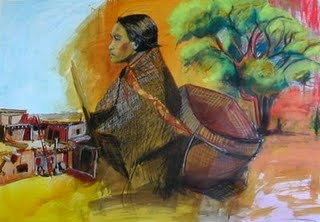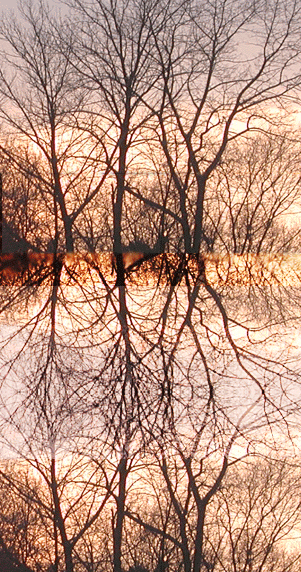Serendip is an independent site partnering with faculty at multiple colleges and universities around the world. Happy exploring!
Notes Towards Day 15: Literary Interpretation

Literary Interpretation, or
"It's Hard to See the Forest When You're a Tree"
(have it all read, because:)
Due on SATURDAY by 5 p.m. [NOTE EXTENSION!]:
3 pp. interpretation of the novel,
from Hyde or Allen's p.o.v.:
how it works, what's going on, what's important?
(i.e.: what does Hyde's coyote have to do w/ the coyotes in the novel?
what would Allen say about the structure of foreground/background?)
Before Thursday's class, post your initial thoughts about this:
a kind of "story starter"...
learning to be succinct/focused/keeping to the main idea--
and giving data to support it.
Let's see how we did this on our most recent project,
(really a "snapshot" of how a paper might work):
What did we learn? Have/how have we revised our own initial reactions?
(Also, finishing up from last week's project?
Anna reading Emily, Hoang reading Ellen?)
one to tell the Yellow Woman story
one to give the modern feminist interpretation
one to give the Indian-feminist interpretation
Lewis Hyde:
trickster derives creative intelligence from appetite
invents the fish trap, gets snared in own devices
incremental intelligence re: hunting--
can imagine trap because he's been prey
(evolutionary bio: predators brainier than prey--
engine driving creation of intelligence)
third role, beyond predator/prey: bait-thief tricksters
critique rules of eating game
trickster satiates own hunger, subverts all hunger not his own:
trickster's intelligence to feed self, outwit other eaters w/ non-oppositional strategy
"Raven Becomes Voracious": all who eat must be eaten (circularity)
law of appetite, of ecological interdependence
most trickster tales re: hunger and its consequences
two options: limited food or limited appetite
suffering from unrestrained appreties leads to
consciousness regarding them
Promethean sacrifice: as result of foolish trick,
humans stuck with endless hunger (origin of appetite)
sacrifice=ritual apportionment
intentional sacrifice as attempt to alter appetite:
to eat without compulsion or consequences
2) trickster travels aimlessly, has "context of no context,"
wanders blindlessly
vs. species knowledge: situated in space by nature
cf. animals with a way of being in the world ("nature") with
coyote, who can copy, but has no ability of his own:
but has a repertoire of ways: power of imitation, ability to adapt/
plasticity of behavior, can survive in shifting world
are vulnerable to predator wise to ruse
traps of instinct exploit inborn methods/trapped in own defense
invention of creative lying
opportunity: "porta"/passage/entrance/opening
all theft opportunity theft: trickster a pore-seeker
--and trapper: blocking opportunity/
creating the impenetrable/non-porous
--blocking entrances: turning pores into barriers ("aporia"=contradiction/paradox)
trickster's mind: exploits/frustrates opportunity
trickster doubles back/reverses self: "confounded polarity"
tricksters/tracking=reading/writing=encoding/decoding (humor)
Hermes, Odysseus, Alcibiades,
How does this analysis resemble/diverge from that of

who offers us a way of reading she calls
"tribal-feminism or feminist-tribalism....
Often what appears to be a misinterpretation caused by
racial differences is a distortion based on sexual politics."
What's the forest? What's the tree?
"Language embodies the unspoken assumptions and orientations of the culture it belongs to..."
"The world resists language as the grain of a tree resists the saw, and saws take the form they do partly because wood is what it is. We sense the presence of things through this resistance....." (Robert Scholes)
(as translated by Allen's mother's great-uncle)

- A KERES INTERPRETATION:
a narrative version of a ceremony related to the planting of corn, transfering focus of power, with assumptions...of balance and harmony...sense of rightness, or propriety...fundamental principle of proper order...ritual agency in conflict-phobic culture
- A MODERN FEMINIST INTERPRETATION:
use of passive female figure as pawn in male bid for power...
useful in instructing women in their obligation in revolutionary struggle
(assumes that conflict is basic to human experience and that
women are essentially powerless)
- AN INDIAN-FEMINIST INTERPRETATION?

- tribal habit of mind toward equilibrium of all factors
- even distribution of value among all elements in a field
- no single element foregrounded...no heroes, no villains
- no chorus, no "setting"...no minor characters...
- foreground slips along from one focal point to another until all the pertinent elements in the ritual conversation have had their say...
- focus of the action shifts...there is no "point of view"....

"Perceptual modes...are more resemblant of open-field perception than of foreground-background perceptions....Traditional peoples perceive their world in a unified-field fashion that is far from the single-focus perception that generally characterizes Western masculinist monotheistic modes of perception."
Do you think that it is even possible for us to look this way,
using unified- or open-field perception?
of the plot and process of a traditional tribal narrative...."


